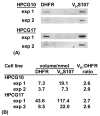Nucleotide excision repair in an immunoglobulin variable gene is less efficient than in a housekeeping gene
- PMID: 17336386
- PMCID: PMC1925044
- DOI: 10.1016/j.molimm.2007.01.018
Nucleotide excision repair in an immunoglobulin variable gene is less efficient than in a housekeeping gene
Abstract
Immunoglobulin variable genes undergo several unusual genetic modifications to generate diversity, such as gene rearrangement, gene conversion, somatic hypermutation, and heavy chain class switch recombination. In view of these specialized processes, we examined the possibility that variable genes have intrinsic characteristics that allow them to be processed differently in the course of basic DNA transactions as well. This hypothesis was studied in an experimental system to gauge the relative efficiency of a DNA repair pathway, nucleotide excision repair, on a variable gene and a housekeeping gene. DNA damage was induced by ultraviolet light in murine hybridoma B cells, and repair was measured over time by an alkaline Southern blot technique, which detected removal of cyclobutane pyrimidine dimers. The rate of DNA repair in a rearranged variable gene, V(H)S107, was compared to that in the dihydrofolate reductase gene. Although both genes were actively transcribed, the V(H)S107 gene was repaired less efficiently than the dihydrofolate reductase gene. These results suggest that variable genes have inherent properties that affect the efficiency of nucleotide excision repair.
Figures



References
-
- Bohr VA, Smith CA, Okumoto DS, Hanawalt PC. DNA repair in an active gene: removal of pyrimidine dimers from the DHFR gene of CHO cells is much more efficient than in the genome overall. Cell. 1985;40:359–369. - PubMed
-
- Bohr VS, Okumoto DS, Ho L, Hanawalt PC. Characterization of a DNA repair domain containing the dihydrofolate reductase gene in Chinese hamster ovary cells. J Biol Chem. 1986;261:16666–16672. - PubMed
-
- Celano P, Baylin SB, Casero RA., Jr Polyamines differentially modulate the transcription of growth-associated genes in human colon carcinoma cells. J Biol Chem. 1989;264:8922–8927. - PubMed
-
- Crouse GF, Simonsen CC, McEwan RN, Schimke RT. Structure of amplified normal and variant dihydrofolate reductase genes in mouse sarcoma S180 cells. J Biol Chem. 1982;257:7887–7897. - PubMed
Publication types
MeSH terms
Substances
Grants and funding
LinkOut - more resources
Full Text Sources

